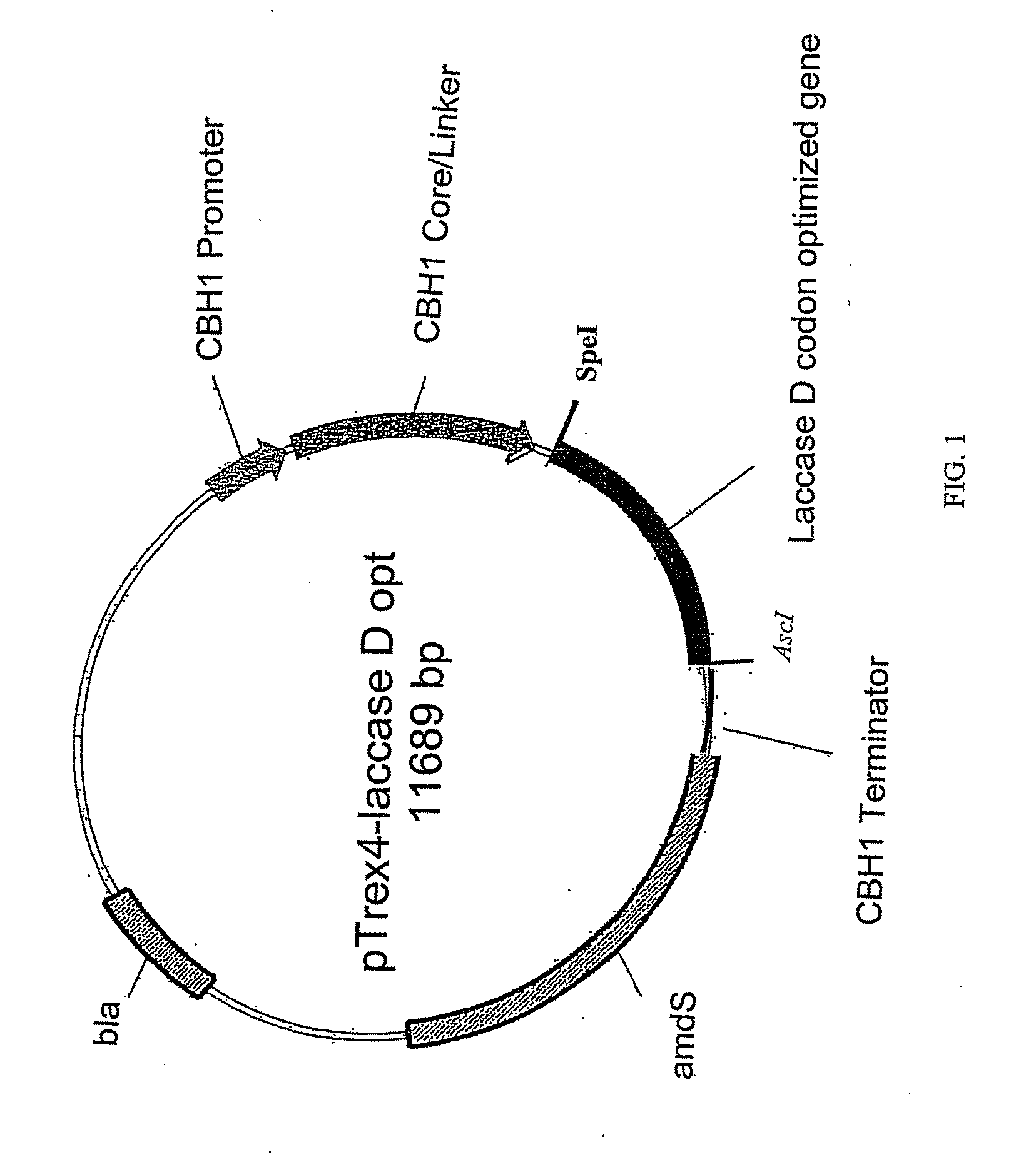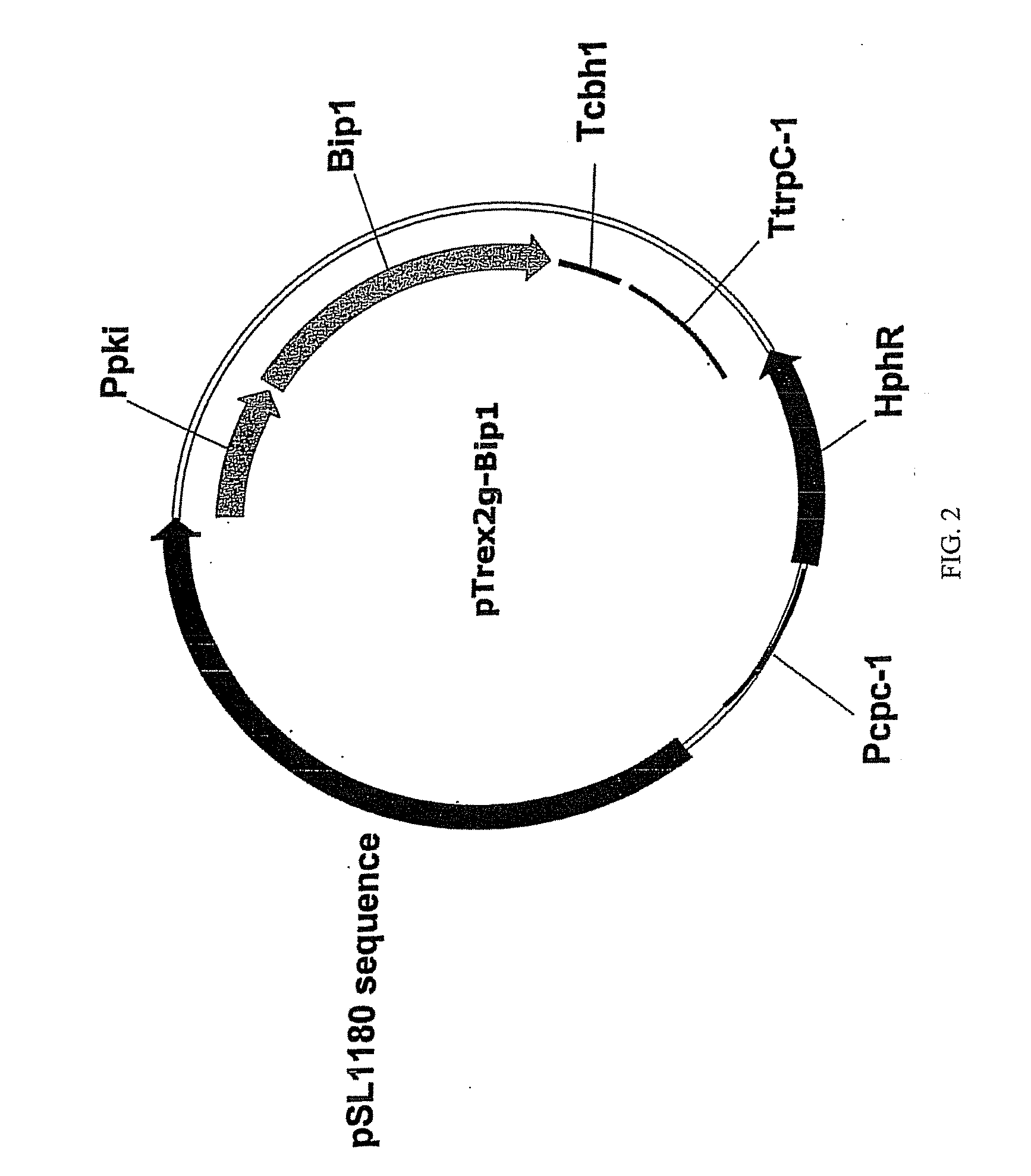Signal sequences and co-expressed chaperones for improving protein production in a host cell
a technology of signal sequences and coexpression, which is applied in the direction of hydrolases, biochemistry apparatus and processes, and enzymes, can solve the problems of further complicated expression of desired proteins and poor secretion, and achieve the effect of increasing the expression of proteins fused and increasing the production of proteins
- Summary
- Abstract
- Description
- Claims
- Application Information
AI Technical Summary
Benefits of technology
Problems solved by technology
Method used
Image
Examples
example 1
Construction of Expression Vector pTrex4-laccaseD opt
[0140]This Example describes the steps involved in the construction of the expression vector pTrex4-laccaseD opt. The plasmid was produced to express the codon optimized laccase D gene from C. unicolor using the CBH1 promoter and CBH1 signal sequence. This expression vector contained the laccase D codon optimized gene fused to the CBH1 (cellobiohydrolase) core / linker and expressed from the CBH1 promoter. FIG. 1 provides a schematic of the Trichoderma expression plasmid. The sequence of the pTrex4-laccaseD opt plasmid is shown as SEQ ID NO: 1. The following segments of DNA were assembled in the construction of pTrex4-laccase D opt (See, FIG. 1). A fragment of T reesei genomic DNA representing the CBH1 promoter and the CBH1 signal sequence and CBH1 core / linker was inserted into the plasmid pSL1180 vector. A codon optimized copy of the C. unicolor laccase D (laccase D opt) gene was inserted, such that it was operably linked to the CB...
example 2
Construction of Expression Vector pTrex2g-Bip1
[0141]The pTrex2g / Bip1 plasmid was produced to express the bip1 chaperone from T. reesei. FIG. 2 provides the schematic of the Trichoderma expression plasmid pTrex2g-Bip1; The sequence of the plasmid is provided as SEQ ID NO: 2. The following segments of DNA were assembled in the construction of pTrex2g-Bip1. A 2267 bp fragment of T. reesei bip1 was inserted into the plasmid pSL1180 vector operably linked to the Ppki promoter (pyruvate kinase from T. reesei), The Trichoderma cbh1 terminator was operably linked to the bip1 gene. The HphR selectable marker from E. coli was included for selection and was operably linked to the Pcpc-1 promoter (cross pathway control-1 gene from Neurospora crassa) and the trpC terminator (tryptophan synthesis gene C from A. nidulans).
example 3
Construction of Expression Vector pTrex2g-Pdi1
[0142]The pTrex2g-Pdi 1 plasmid was produced to express the chaperone pdi1 in the same way as the pTrex2g-Bip1 (See, Example 2), except that the T. reesei pdi1 chaperone gene (2465 bp) was inserted in place of the bip1 chaperone gene. FIG. 3 provides the schematic of the Trichoderma expression plasmid pTrex2g-Pdi 1; the sequence of the plasmid is provided as SEQ ID NO: 3.
PUM
| Property | Measurement | Unit |
|---|---|---|
| pH | aaaaa | aaaaa |
| volume | aaaaa | aaaaa |
| volume | aaaaa | aaaaa |
Abstract
Description
Claims
Application Information
 Login to View More
Login to View More - R&D
- Intellectual Property
- Life Sciences
- Materials
- Tech Scout
- Unparalleled Data Quality
- Higher Quality Content
- 60% Fewer Hallucinations
Browse by: Latest US Patents, China's latest patents, Technical Efficacy Thesaurus, Application Domain, Technology Topic, Popular Technical Reports.
© 2025 PatSnap. All rights reserved.Legal|Privacy policy|Modern Slavery Act Transparency Statement|Sitemap|About US| Contact US: help@patsnap.com



